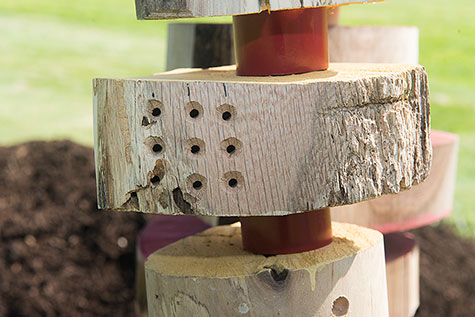
Bee populations are down — way down, as much as 50 to 70 percent.
It’s a disturbing trend and, over the last several years, beekeepers from around the world have begun sounding alarms. Yet causes remain unclear. Pesticides? Climate change? Lost habitat? Irregular food supplies? All of the above?
But one thing is certain — the bees need help.
“When people think about bees, they mostly think about honey,” said Charling Chen, a 2013 architecture graduate in the Sam Fox School of Design & Visual Arts. “But plants rely heavily on bees for pollination, which makes them crucial to both food production and biodiversity.”
Last fall, Chen and three other Sam Fox School students — juniors Shannon Slade and Anna Villanyi and master’s candidate Bingbin Zhou — were among 28 from around the world selected for PAUSE, or Pollinators/Art/Urban Agriculture/Society/and the Environment.
The one-year, $200,000 project represents a partnership between the St. Louis Zoo WildCare Institute, the National Museums of Kenya and Tohono Chul Park in Tucson, Ariz. Working in teams of eight to 10, participants met with gardeners, scientists and other experts to create pollinator habitats in St. Louis, Tucson and Nairobi.
“With this kind of project, the challenge is getting people from different backgrounds and different disciplines into the same room,” said Chen, who traveled to Nairobi as part of a “cross-cultural pollination.”
As an architect, Chen said she “really loved working with ecologists, etymologists, beekeepers — people who can confirm whether a particular design will work or not.”
Back in St. Louis, the PAUSE team worked with Gateway Greening and the City of Florissant to identify a site, eventually settling on the 3.5-acre Florissant Community Garden, 601 St. Charles Street (near the Old St. Ferdinand Shrine) in North St. Louis County.
To help manage transitions between cultivated and natural woodland areas, the group developed a conceptual masterplan, which they presented to the Florissant City Council. At the same time, they zeroed in on one key element: a central “pollinator garden” anchored by an original sculpture crafted from tree trunks, bicycle wheels, wire hangers and other recycled materials.
“It’s just things we found in the trash,” Chen said with a smile. “The wood is a mix of maple, cedar and oak. We drilled holes into them at different sizes, because different bees have different preferences.”
Though proud of the final project, which the group installed at the end of June, Chen noted that it represents “just the tip of the iceberg” in terms of pollinator-friendly design.
“There’s so much potential here,” she said, “but our site is really young. It will take years to fully develop.
“You don’t grow a garden in a day.”